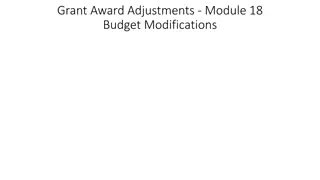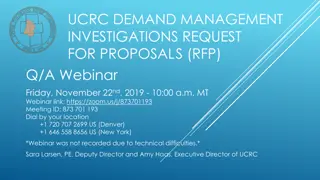The Importance of Change for Local Government and Communities
All potential changes in the NSW Local Government sector are imposed upon, rather than initiated by, individual local governments. Australian local government is viewed as expedient rather than political or ethical. Place-shaping and localism are emerging ideologies internationally, driven by larger, empowered local governments. Despite some cynicism, there is demonstrated potential for positive outcomes in devolving authority. Legislative frameworks in Australia require Community Strategic Plans, prompting inter-jurisdictional comparisons and questions about the balance of planning. A case study of the City of Greater Geraldton in WA showcases innovative approaches to vitalize democracy through community participation.
Download Presentation

Please find below an Image/Link to download the presentation.
The content on the website is provided AS IS for your information and personal use only. It may not be sold, licensed, or shared on other websites without obtaining consent from the author.If you encounter any issues during the download, it is possible that the publisher has removed the file from their server.
You are allowed to download the files provided on this website for personal or commercial use, subject to the condition that they are used lawfully. All files are the property of their respective owners.
The content on the website is provided AS IS for your information and personal use only. It may not be sold, licensed, or shared on other websites without obtaining consent from the author.
E N D
Presentation Transcript
The Importance of Change: What s in it for Local Government and Communities? Dr Bligh Grant UNE Centre for Local Government
Change? Potentially, lots of it in NSW Local Government Sector At least 5 major review processes: 1. Destination 2036 Consultative Reform Process; 2. Local Government Acts Taskforce to rewrite the 1993 Local Government Act (NSW) and the 1988 City of Sydney Act; 3. Independent Local Government Review Panel; 4. NSW Planning System Review +Green Paper 5. NSW Auditor General s Monitoring Local Government Report
Summary: All of these potential changes are imposed UPON local government, rather than being initiated BY individual local governments; Australian local government is generally treated as expedient (or instrumental) rather than political (or ethical) in its own right (historically understandable see A.J. Brown [2008]!!); Even claims about local democracy ( local voice + local choice ) are grounded in the allocation of preferences, rather than being about politics, properly conceived.
Place-shaping + Localism as Political Ideologies Internationally (U.K., derived from the U.S.A.) big push for identity or ideational politics based on place to be a part of local governance, LED BY local governments (larger, fiscally empowered local governments) with Strong leadership and Devolution of authority to LGs. Easyto be cynical about this (devolution of authority = cost shifting). However: Potential has been demonstrated in case studies (as I hope to show...).
Legislative basis for place-shaping in Australia ALG are creatures of statute and as such subject to arbitrary reconfiguration + oversight; HOWEVER: LGB in ALL Australian jurisdictions are now required to produce Community Strategic Plans (i.e.: 10+ year visions ) as an element to complex, inter-jurisdictional planning webs (Grant, Dollery + Kortt, 2011); Interesting inter-jurisdictional comparisons ( institutional mimesis , or COPYING); Again, room to be cynical about this (how much planning is too much?; Tyranny of Community ?)
Case Study: City of Greater Geraldton, WA One of 7 finalists for the Reinhard Mohn Prize (award offered by the Bertelsmann Stiftung, a German philanthropic organisation. Geraldton 2029 and Beyond for Vitalising Democracy through Participation (157 entries). Initially, Bligh was EXTREMELY SKEPTICAL about this project: Had all the hallmarks of an expensive, outsourced community plan; International consultants employed (e.g.: Charles Landry, author of The Creative City: A Toolkit for Urban Innovators (2008) What does creativity have to do with a mining boom??
1. Spatial + Socio-economic Characteristics Result of two consecutive AMALGAMATIONS: City of Geraldton and the Shire of Greenough in 2007; City of Geraldton-Greenough with the Shire of Mullewa City of Greater Geraldton in July 2011 i.e.: ANTI- IDENTITY FORCES Significant Economic Growth due to mining boom, e.g.: mean taxable income increased by 14.6% in Geraldton- Greenough and by almost 40% in Mullewa (ABS, 2009/10). Private sector homes increased by 44.5% in Geraldton- Greenough and a recorded $180,000 or an increase of a factor of 6 in Mullewa (ABS, 2009/10). Worried about social problems a la The Pilbara
2. Legislative Framework: Fabricating Community? The information required, processes and outputs of Strategic Community Plan development are detailed below What do I have to gather? What do I do? What do I end up with? Identified community well-being issues Community engagement stakeholders, methods Strategic Community Plan (10+ years) -Vision - Priorities - Objectives - Strategies - Assessment. Identified services expectations Identified asset expectations Identified land use expectations Identification of how we know the plan is succeeding Informing strategies. Identified social inclusion issues Community long term visioning and priority setting Internal strategy and research on emerging trends Strategy and research of trends and long term impacts Demographics State/National legislation or policy Review and understand the interdependencies between community planning, services, assets and land-use Known State/National events that may impact Local area/place planning information Local area/place-planning processes Quadruple bottom-line analysis: Social, Economic, Environmental, Civic Leadership Review and understand broad resource implications of Strategic Community Plan Changing external factors such as global events that may impact on WA/community Strategic community plan reviews
3. Community Engagement in Geraldton 14 other government agencies + members of community + media (local paper) + consultants; Community Champions running World Cafes Deliberative Survey Poll Online deliberation with the City Staff and Community Participatory Budgeting Preliminary Phase Youth Online Involvement 21st Century Town Hall Meeting Alignment of the Strategic Plan and the Budget Community Champions Open Space Technology training for facilitation
4. Strategic Directions (x 10) and Recommendations 1. Welcome and facilitate all sectors of the Community to participate in the City s cultural life, e.g.: Develop an Ageing Together plan; 2. Deliver access to facilities to support those living in, visiting and working in a creative City, e.g.: Develop an Art Civic Studio for families 3. Promote the City of Geraldton-Greenough as a City for the Arts and as a Regional recreational hub, e.g.: Develop and stage a Windfest to celebrate and promote Geraldton s unique landscape and lifestyle 4. Diversify the economy, e.g.: Develop a Technology Park
Strategic Directions + Recommendations 5. Protect Geraldton-Greenough s distinctive physical character ... Heritage ... and identity, e.g.: engage community members on the planning and design teams for recreational and public spaces 6. Attract investment by creating live/work zones for artists, e.g.: encourage the development of affordable housing and live/work space for artists and curators 7. Stimulate trade through cultural tourism, e.g.: develop an Indigenous Cultural Tourist Centre 8. Attract, facilitate and maximise the benefits of major City events and festivals, e.g.: bid for Australian Travel Writers Association (ASTW) AGM
Strategic Directions + Recommendations 9. Engage Youth, e.g.: develop a Youth Media Organisation 10. Connect Creative Rural Communities, e.g.: employ a Rural Community Development Officer who is based rurally who works in collaboration with the other CDOs and in partnership with regional stakeholders SO WHAT DO WE MAKE OF ALL THIS???
Critical Reflections 1. Feels very much like a wish list; 2. Actual outcomes still to be assessed; 3. Significant transaction costs AND opportunity costs involved; 4. Dialectic of community engagement and tyranny of community still represent forceful arguments; 5. Place-shaping in this sense is not an egalitarian model of reform
Generally: Bell and Hindmoor (2008, 139): best case scenario for CE, where such consultation becomes an on-going dialogue involving mutual learning and accommodation , is precisely that: a best-case scenario. Alternatively: at its worst, CE is tokenistic and creates a sense of betrayal when communities believe that their views have been ignored . City of Greater Geraldton s CE process will, in all probability, fall between these two extremes. Nevertheless, at its most immediate, the process presented here suggests that community engagement can do much to engendering regionalism from the local level.























